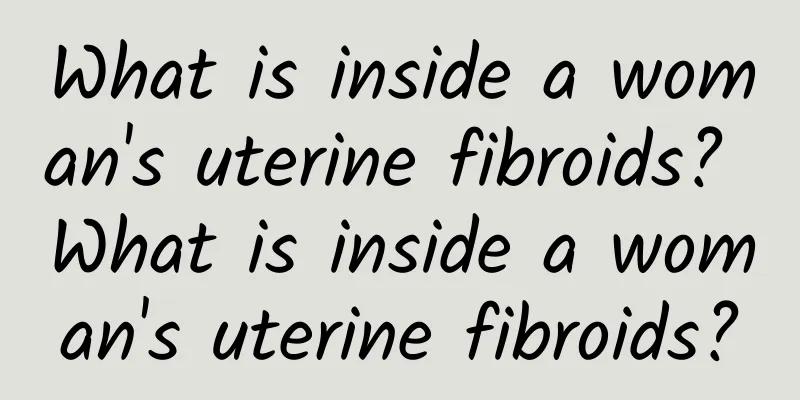The most common clinical manifestation of uterine fibroids is menstrual changes in women.

|
I believe that many women would like to know the clinical manifestations of uterine fibroids, which is very helpful for the treatment of uterine fibroids. In order to let more women know about the clinical manifestations of uterine fibroids, let's focus on the clinical manifestations of uterine fibroids. Experts point out that although uterine fibroids are clinically benign tumors, if not discovered in time, they will endanger multiple organs of the body and may also cause infertility. What are the general clinical manifestations of uterine fibroids? Uterine fibroids can be divided into the following three clinical manifestations according to their growth location: Intramural fibroids are located in the myometrium and are the most common clinical manifestation of uterine fibroids. Fibroids that grow toward the uterine serosa and protrude from the surface of the uterus are called subserosal fibroids, accounting for 20% to 30% of the total. Fibroids that grow toward the mucosal layer and protrude into the uterine cavity are called submucosal fibroids, which account for 10% to 15% of the total clinical manifestation of uterine fibroids. Experts say that the most common clinical manifestation of uterine fibroids is menstrual changes: such as shortened menstrual cycle, prolonged menstrual period or increased menstrual volume, especially heavy bleeding in a short period of time. The clinical manifestations of uterine fibroids can cause severe anemia in patients. When the fibroids grow larger, the clinical manifestations of uterine fibroids can compress adjacent organs and cause frequent urination, constipation, hydroureter, hydronephrosis, etc. Fibroids are generally painless, but if the pedicle of a subserosal fibroid is twisted, the clinical manifestation of uterine fibroids can cause acute abdominal pain; submucosal fibroids can stimulate uterine contractions and cause spasmodic pain. When the fibroids turn red, they can cause severe pain. The clinical manifestation of uterine fibroids can also cause increased leucorrhea and infertility. Are you curious about the clinical manifestations of uterine fibroids? In order to let you know more about the clinical manifestations of uterine fibroids, the above is an introduction to the clinical manifestations of uterine fibroids. It is for your reference only. If you have any questions about the clinical manifestations of uterine fibroids, please consult our online experts. For more information, please visit the uterine fibroids topic at http://www..com.cn/fuke/zgjl/ or consult an expert for free. The expert will then give a detailed answer based on the patient's specific situation. |
<<: Clinical manifestations of uterine fibroids can easily lead to female infertility
>>: Basic clinical manifestations of acute pelvic inflammatory disease
Recommend
Six details to prevent dysmenorrhea explained one by one
As more and more dysmenorrhea patients appear in ...
Experts explain the common causes of ectopic pregnancy
Ectopic pregnancy is one of the more serious gyne...
What is it like to have uterine fibroids? Will uterine fibroids lead to infertility?
Uterine fibroids (Hysteromyoma) Uterine leiomyoma...
It is indispensable for ketogenic weight loss! Long-term insufficient protein intake can lead to four major discomfort symptoms
Women who want to lose weight and love beauty oft...
What is Ⅲ degree cervical erosion? Medical definition of Ⅲ degree cervical erosion
Grade III cervical erosion is actually the most s...
Experts briefly introduce the common stages of dysmenorrhea
There are many stages of dysmenorrhea in clinical...
Eat tonic food without eating fat! Chen Chaozong: Medicinal tea drinks to reduce fat and replenish qi
Many people would say that it is the most difficu...
To prevent the occurrence of ovarian cysts, you need to pay more attention to everything
In life, how should we take preventive measures a...
How much does it cost to treat vaginitis?
Vaginitis is a gynecological disease with a high ...
Early clinical symptoms of cervicitis
Cervicitis has seriously affected our lives in re...
Detailed discussion of the symptoms and manifestations of heavy bleeding uterine fibroids
It is important to understand the symptoms of ute...
What are the hazards of cervical erosion? 3 symptoms that cervical erosion may cause
Cervical erosion can lead to increased vaginal di...
Introduction to abnormal vaginal discharge
Under normal circumstances, leucorrhea is a white...
The benefits of exercise for vaginal candidiasis
Women with candidal vaginitis can effectively rel...
Don’t want to sweat while losing weight? 7 slimming porridges to help you lose weight
[Key Points]: Many girls want to lose weight with...









